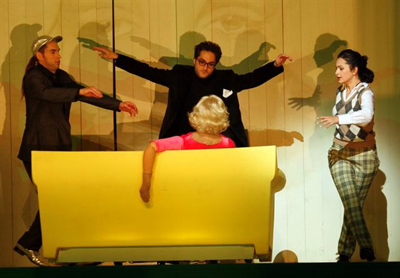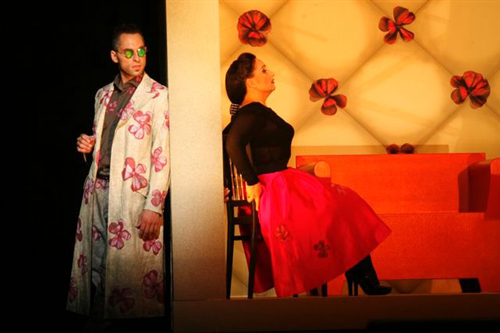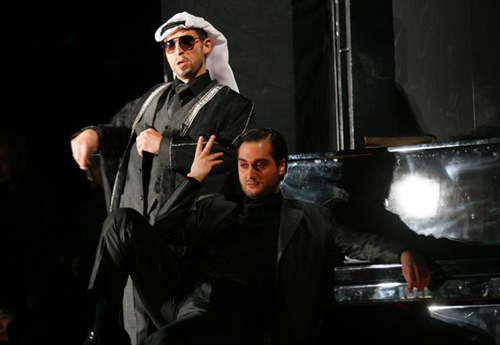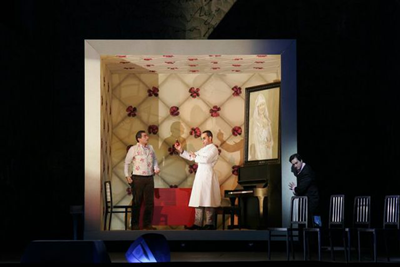I was amply rewarded for the five-hour train trip.
Having “discovered” Mr. Ketelsen as (already) a world-class “Leporello” in
the Glimmerglass “Giovanni” (rivaling my memories of Walter Berry), I was
next wowed by him in a star-making turn in the little-performed “Maskerade”
(Nielsen) at none other than Covent Garden. It was a triumphant tour-de-force
that was roundly cheered by that discerning public (and critics). It is no
accident that he has repeatedly been invited back for his signature Mozart
roles and Escamillo, among others. Happenstance found me next at a Seattle
Mozart “Requiem” where, undistracted by stage business and costumes, I
luxuriated in his just-plain-gorgeous sound in a memorable “Tuba Miram.”
To the opera at hand, then, how were his “four villains”? Well, confirming
my previous experiences, they were beautifully sung, the sizable voice steady
and responsive, seamless throughout the roles’ rangy demands, capable of
great variety and detail, excellent French diction, and all wrapped up in a
handsome stage presence. He is one of those treasurable artists that can
totally inhabit a role, all the while singing with great beauty and
understanding. If he does not have the stock villainous “snarl” that older
(or less refined) voices might bring to it, well, all the better as far as I
am concerned.
Let’s get all the “happy” news on the table, shall we? Musically, “Les
Contes d’Hoffmann” was very fine, indeed. Tenor Giuseppe Filianoti has been
singing all over the map, at many major houses including the Met, and he
deserves to. This is a well-produced, full-sized lyric instrument with enough
heft and point in it to edge into a slightly heavier Fach like this one. He
sang with sensitivity and passion, if at times with a slight Italianate
“catch” in the voice (okay, okay, he is Italian!). And he is
apparently tireless, pouring out searing, balls-to-the-wall phrases and
hushed introspective musings alike throughout the evening. Indeed, at opera’s
end, he seemed as fresh-voiced as at the start. Committed actor. Good
looking. Major talent.
Although soprano Elena Mosuc was announced (with some drama) as indisposed
(with three different ladies on hand to spell her if needed), it was hard to
tell from her authoritative portrayal of the four heroines. All the
coloratura was finely-tuned for “Olympia;” a fuller, warmer voice was
summoned for “Antonia;” and the necessary requirements were met for a good
embodiment of “Giulietta.” While I personally find the opera better served by
three different voice types, a true diva aficionado is always more intrigued
by one lady able to encompass all. And that the attractive Ms. Mosuc
certainly does, with considerable success.
 Ketelsen (Coppelius), Filianoti (Hoffmann) and Surguladze (Nicklausse)
Ketelsen (Coppelius), Filianoti (Hoffmann) and Surguladze (Nicklausse)
with “Olympia”
Nino Surguladze as “Nicklausse” displayed a rich, full mezzo which rather
surprisingly emitted from a mere slip of a girl; Deborah Humble provided
burnished tone for an honorable turn as “Antonia’s Mother;” and tenor
Benjamin Hulett had some wonderful comprimario moments in his four roles.
Smaller parts were mostly very well taken and the responsive orchestra played
with fine style under Emmanuel Plasson (yes, son of “that other Plasson”).
And this pretty much concludes the great news portion of
the evening, for the physical production was somewhat a well-intended grab
bag.
I am very nearly ready to start a petition to banish “The Mysterious Cube”
from the repertoire of Euro-Scenery. Yes, the whole set was a boxy cube,
within which (most of the time) a smaller cube resided, which rotated to
reveal our leading ladies through an open fourth wall, or as I refer to it:
“Diva in a Box.” Sometimes it just played Sit-‘n’-Spin for no good reason.
And just when you thought this thing couldn’t be any uglier,
dang if they didn’t reveal a yellow interior re-dressed with garish painted
posies all over it; or outfitted it with the flopping-est, most
hand-print-smeared Mylar mirror panels I ever hope to see. Designer Hartmut
Schoerghofer is on the blame line for this creation.
A blue scrim began each act with well-intended but hard-to-see
projections, the first being (I think) disembodied hands – or were they
condoms? – nope, they must have been hands ‘cause they later “applauded” when
the show-within-a-show’s “act” was over. That business over, the set-up
seemed that we were in the Kantine of the theatre where Stella was
performing. It was awfully trendy for a Kantine, though. In fact if we were
to believe the employees’ tee shirts, it was called “La Diva” (get it?). Four
TV monitors showed what was going on “on-stage.”
A hip and handsomely clad “Lindorf” arrived with a rolling suitcase of
minor importance later. The crowd that populated this space at “intermission”
included a mix of opera-goers, cast, and crew. A tortured “Hoffmann” entered
with “Nicklausse” dressed as his Girl Friday. It must be said the energetic,
dedicated cast was immersed in their assignments, and plunged wholeheartedly
into everything that was asked of them by director Christine Mielitz.
But did she have to ask “Hoffmann” to be all bug-eyed and off-putting? Did
he have to thrust his pelvis savagely and snap his fingers on his tale of
“Kleinzach” so that he looked like a tryout for the “Jets” in a high school
production of “West Side Story”? Did the chorus have to jive and weave and
bop like White People Dancing Badly? (In a horrifying flashback, the sight
reminded me of the terrible Wisconsin wedding dances of my youth. .
.Brrrrrrr)
As our disagreeable hero became obsessed with the video-feed of Stella on
one of the TV monitors, he took it off its shelf and schlepped it to the
prompter’s box. And then something happened that became my metaphor for the
whole evening’s staging: the damn’ thing sputtered and unintentionally went
blank. Oh, he covered, and turned the face of it away from us, but the ill
omen was communicated. . .
 Kyle Ketelsen (Dr. Miracle) and Elena Mosuc (Antonia)
Kyle Ketelsen (Dr. Miracle) and Elena Mosuc (Antonia)
There was at first something quite clever in presenting “Olympia” as a
“Marilyn” pop icon, and in having “Cochenille” got-up as Michael Jackson,
although having the diva as “Madonna” may have been more apropos. This act
was by far the most imaginative direction, compromised as it was with
gratuitous futzing around by the chorus, and well, way too much of a (pretty)
good thing. “Michael” got visually tiring after a very short while, operating
the doll with a twinkling remote. As for poor “Marilyn”:
First, she was a dummy seen from the back, seated on a sofa in “The Diva
Box;” then as the real soprano, costumed in a pink (make that
PINK) form-fitting short-skirted dress with ample bosoms and
buttocks. “Hoffmann” became sex-obsessed (perhaps harking back to those
pelvic thrusts), leering at these features like a testosterone-driven
juvenile. He became absolutely inflamed when “Cochenille” blew into a tube
attached to her, thereby inflating her breasts even larger (shades of
“Passionella”!). Later, after the introduction of a helium canister on-stage,
“Mr. Cube” turned to reveal a reclining Macy’s Parade giant doll, one breast
bared, legs spread, ready for action. That “Hoffman” breaks his magic glasses
fainting backwards between her thighs onto her belly, made
no sense.
“Coppelius” rolled in the carry-on suitcase to reveal the requisite cogs
and gears inside, and then mostly lurked in and around the cube in a
pony-tailed ball cap. His last say in “dismantling” the doll consisted of
blowing its head off with a Kalishnikov. While there was no sound effect,
there was a film projection of splattered brains running down the wall that
would have made John Carpenter proud. And now an “aside” on Renate
Schmitzer’s costumes. . .
Okay, the concept for “Olympia” was rather an MTV-like disco scene, but
was it wise to put the entire chorus in lime green, clinging scoop neck tops
with big red Rocky Horror lips on the front of each? And annoying “trendy”
accoutrements, like the twinkling bows (or was it heels?) on all the chorus
girls’ shoes? This is not the sort of thing that looks good on people of a
certain age, and let’s face it, 90% of opera choristers are
“a certain age.”
Act Two began with a giant Mylar false proscenium flying in, and then with
a loud thunk tipping forward to weakly reflect an overhead
view of the real pit musicians. Unfortunately, this and a (rather lovely)
floating violin distracted from “Nicklausse’s” well-sung air. As visual
compensation, she and “Hoffmann” crossed and formed a beautiful, Pieta-like
tableau with a white-clad-as-Virgin-Mary “Antonia’s Mother.”
“Antonia,” first seen in a black pants suit, later appeared for her
descent into death with slacks traded for a pink skirt (please note: color
motif tie-in). “Miracle” arrived in a doctor’s white smock and wonderful
“Wiz”-like reflective green glasses , then reappeared in a similar smock that
boasted flowers matching the wallpaper. Ditto her father’s look. The sicker
she got, the more posies appeared. In fact, this act was most successful
“tale” as far as the quite witty costumes.
However, some real oddities included the addition of faux pianos to each
outside wall of “The Cube”; a hanging portrait of Mom that just didn’t “read”
in the audience, even before “Mother” surprisingly tore the
“canvas” out from behind; and “Miracle” performing his evil ministrations to
an empty chair, while the doomed “Antonia” looked on from Cube’s edge.
 Kyle Ketelsen (Dappertutto) and Giuseppe Filianoti (Hoffmann)
Kyle Ketelsen (Dappertutto) and Giuseppe Filianoti (Hoffmann)
A real plus in this “tale” was “Frantz’s” wacky arietta. I usually squirm
through this as the aging character tenor play-acts at “cracking” the high
note, and coughs and wheezes a bit, well, you know, embarrassing, right? In
this case, young Hulett was a closet ballerina, or cross-dresser, or both
(and why not?). As his dance moves gave way to more strip-tease abandon, he
revealed himself to be wearing a camisole, and fishnet stockings, and, after
holding a leg up high to one side while singing the last bars, he ended in a
really decent split to considerable audience approval! No fooling, this was
an inspired moment. One I was still relishing all the way up until . . .
“Antonia” died quite unceremoniously at the prompter’s box, next to the
ill-fated monitor in fact, and was hurriedly covered up with a black cloth.
She was the lucky one, I thought, as Venice was. . .well. . .not pretty.
In fact, it seemed as if the visual and directorial inventiveness, so
promising at the start of the real “tales,” just ran out of steam. This was
as bleak a “Serenissima” as I have never seen. I am not sure
what was supposed to be in “The Diva Box” but it looked like Hernando’s
Hideaway gone bad. The chorus members seated on outer sides of the cube
seemed to be malcontent-ed street people in rags and tatters. I think. The
lighting was so dark it was hard to see. . .chorus. . .principals. .
.anything of note.
“Giulietta” herself was got up in a black turban, pants, and jacket over a
gold bustier which made her look eerily like “Karen” from “Will and Grace” at
a costume party not of her own choosing. “Hoffmann” gave in to the carnal
build-up of three (unnatural) Acts and stripped off his shirt, mounting the
soprano before rolling on his back and being mounted in return. Mercifully
this was mostly masked by the prompter’s box, the dead monitor, and
“Antonia’s” still-covered corpse double.
 The Box
The Box
There is just so much “cube-lurking” that can be passed off as true
direction, and “Dapertutto,” sporting Muslim headgear, was not well served by
uninspired blocking. A performer of this caliber has far more to offer
dramatically than was asked of him here, although a quite beautifully sung
“Scintille, Diamant” was compensation.
This was clearly a bad part of town. As “Nicklausse” looked on in a
Hawaiian tourist shirt, “Hoffmann” violently stabbed “Schlemil,” and shortly
after, “Giulietta.” No kidding, “Giulietta”! I half expected a “Jose” moment
of “Oh, ma Carmen. . .” but instead the Mylar panels on the Cube were a
wiggling-jiggling distraction as they hauled “The Diva Box” up and off, and
poor “Hoffmann” was left half-naked to ponder that he had caused the demise
of all his loves. Or “lusts.” (Okay, okay, excluding “Schlemil”).
Meanwhile, back at the Inn of La Diva, “Dapertutto” (or “Lindorf”. . .or.
. .hell, does it even matter now?) symbolically gave “H” the white “Miracle”
smock to wear. No longer a sex-obsessed juvenile delinquent, he is back to
being an unlikable, ranting jerk of a poet. Having driven “Stella,” “Lindorf”
and everyone away, our hero ended the proceedings curled up in a fetal
position, white-coated, on two stray chairs down right. Blue scrim in. . .
There were actually any number of good ideas here and enough freshly
inventive bits that it was a pity that Ms. Mielick and her design team
settled for a profusion of images and movement that became less and less
focused. The production could be greatly improved by simply imposing some
clarity and discipline in the crowd scenes and, especially, re-considering
singer placement on the stage.
Too often, these excellent soloists were far upstage, behind the action,
in the dark, singing to the wings, and/or not allowed to take the focus to
which they were entitled. Happily, the terrific singing was tremendously
satisfying. (I would travel further than Hamburg to hear Mr. Ketelsen again.)
Plasson led a brisk, committed reading with all the dramatic consistency that
the staging lacked.
Musical glories aside, in the end, just like that hapless prophetic
monitor, this “Tales of Hoffman” production promised much, sputtered briefly,
and ultimately, went dark.
James Sohre
image=http://www.operatoday.com/Hoffmann_Hamburg1.png
image_description=Kyle Ketelsen (Coppelius) and “Olympia” (Hamburg 2007)
product=yes
product_title=Jacques Offenbach: Les Contes d’Hoffmann
Staatsoper Hamburg
product_by=Above: Kyle Ketelsen (Coppelius) and “Olympia”
All photos courtesy of Staatsoper Hamburg